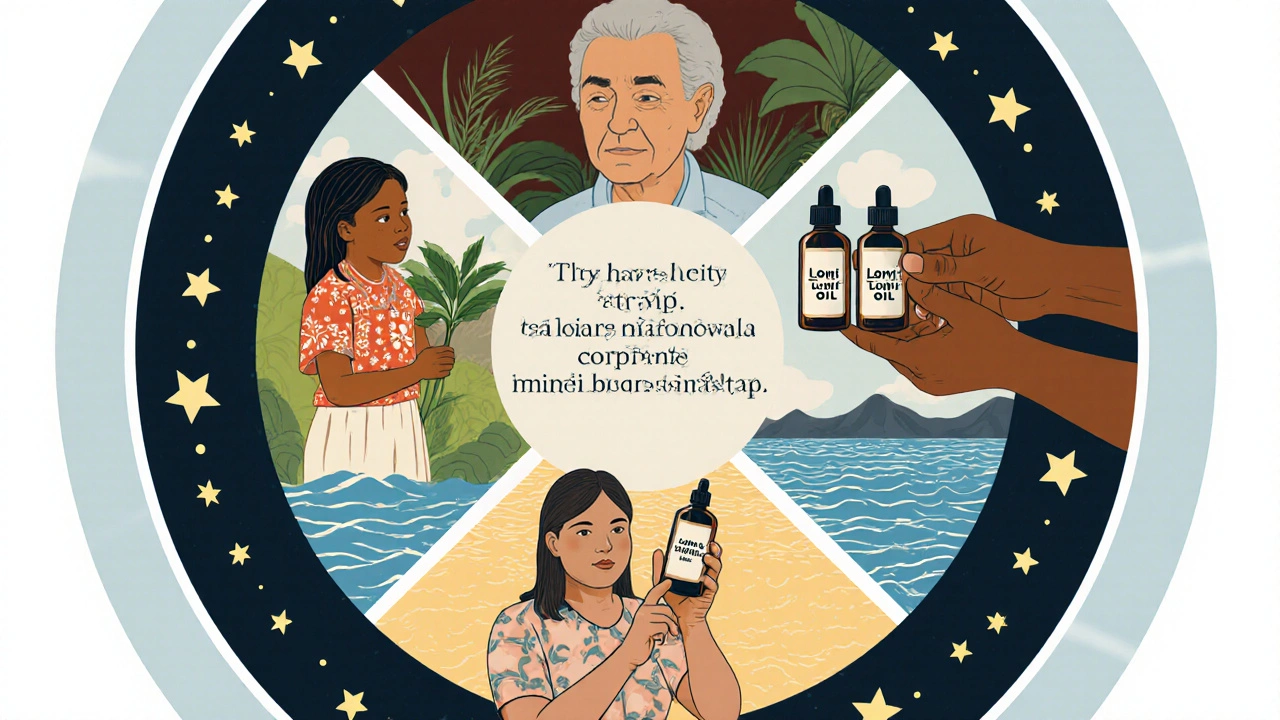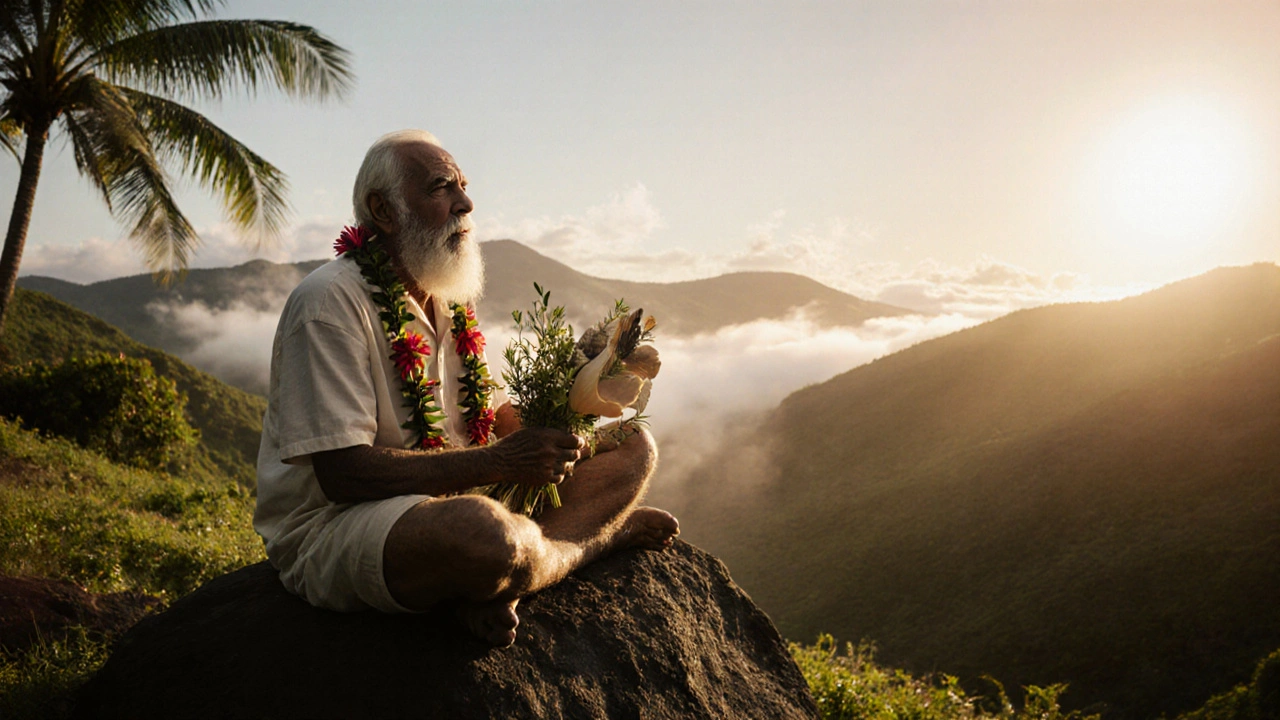Cultural Appropriation Checker
Respectful Engagement Tool
Learn if your wellness practice engagement respects Hawaiian cultural context and lineage.
Most people think of kahuna as mystical healers from old Hawaiian legends-people who whisper secrets to the wind and move stones with their minds. But the truth is, kahuna were never just mystics. They were scientists, therapists, teachers, and community leaders who held deep knowledge of the natural world, the human body, and the mind. Today, that knowledge isn’t locked in ancient chants or forgotten on remote islands. It’s showing up in modern therapy rooms, wellness retreats, and even corporate mindfulness programs.
Who Were the Kahuna Really?
The word kahuna comes from the Hawaiian language and simply means "expert" or "priest." It wasn’t one title-it was many. There were kahuna la’au lapa’au (herbal healers), kahuna hōʻike (spiritual communicators), kahuna kālai waʻa (canoe builders), and kahuna nui (high priests). Each had years of apprenticeship, often starting as children, learning from elders through observation, repetition, and lived experience. Their training wasn’t about magic-it was about pattern recognition, anatomy, psychology, and environmental awareness.
Unlike Western medicine, which often isolates symptoms, kahuna treated the whole person: body, mind, and spirit as one system. A headache wasn’t just a headache-it was a sign of emotional blockage, poor diet, or disrupted relationships. Healing meant restoring balance, not just removing pain. This systems-thinking approach is exactly what modern integrative medicine is now trying to rediscover.
How Kahuna Practices Show Up Today
You don’t need to travel to Oahu to experience kahuna-influenced care. Look closer.
Energy healing modalities like Reiki and Therapeutic Touch borrow heavily from Hawaiian concepts of mana-the life force that flows through all things. Practitioners today talk about "clearing energy blockages" without realizing they’re echoing kahuna rituals that date back centuries. The same goes for breathwork. Ancient kahuna used controlled breathing to shift emotional states, calm the nervous system, and even alter physical sensations. Modern biofeedback and trauma therapy now validate these techniques with brain scans and cortisol tests.
Even massage therapy has roots here. Lomi lomi, the flowing, rhythmic Hawaiian massage, isn’t just about muscles. It’s about releasing stored emotions, reconnecting with ancestors, and restoring harmony. Many spa therapists today teach lomi lomi without naming its origins, turning sacred tradition into luxury commodity.
And then there’s the language. Words like "aloha," "pono," and "lokahi"-once deeply spiritual concepts-are now used in self-help books, corporate retreats, and yoga studios. "Aloha" isn’t just hello or goodbye. It means living with love, respect, and presence. "Pono" means righteousness, balance, and doing what’s right. "Lokahi" is unity-the idea that everything is connected. These aren’t buzzwords. They’re ethical frameworks.
The Hidden Cost of Cultural Appropriation
But here’s the problem: most people using these ideas today have no idea where they came from. Kahuna knowledge was nearly erased. After Western colonization, Hawaiian language was banned in schools. Sacred practices were labeled superstition. Elders were silenced. By the 1950s, fewer than 1,000 fluent Hawaiian speakers remained.
Today, you can buy "kahuna meditation apps," "Hawaiian energy crystals," or "spiritual retreats" led by non-Hawaiians who’ve never set foot on the islands. These aren’t just misleading-they’re disrespectful. Real kahuna knowledge is passed down orally, within families, with deep cultural context. It’s not something you can download or package into a $200 weekend workshop.
When you strip away the language, the lineage, and the responsibility, you turn sacred wisdom into a trend. And that’s not healing-it’s exploitation.

What Modern Society Can Actually Learn
So what’s worth keeping?
First: the idea that health is relational. Kahuna didn’t see illness as something that happens to you. They saw it as something that happens because of you-your thoughts, your relationships, your environment. That’s why modern psychology now talks about social determinants of health. That’s why doctors are starting to ask patients: "Do you feel safe at home?" "Do you have people who support you?" Those questions come from kahuna thinking.
Second: the power of presence. Kahuna taught that attention is energy. Where you focus, your mana flows. Modern mindfulness practices-meditation, journaling, digital detoxes-are just rediscovering this. The kahuna didn’t need apps to be present. They used the rhythm of the ocean, the scent of plumeria, the sound of a conch shell to anchor themselves.
Third: community over individualism. Kahuna worked for the whole village. Healing wasn’t a private transaction. It was a collective act. Today, we’re realizing that mental health crises don’t get solved by pills alone-they need community support, safe spaces, and cultural belonging. That’s the kahuna model.
How to Honor Kahuna Wisdom Today
You don’t have to become a kahuna to honor their legacy. But you can choose to engage with it respectfully.
- Learn from Hawaiian educators, not influencers. Look for programs led by Native Hawaiians, like those at the University of Hawaiʻi or the Kanaeokana organization.
- Support Hawaiian-owned businesses that sell authentic lomi lomi oils, herbal remedies, or cultural workshops.
- Read books written by Native Hawaiians: The Hawaiian Healing Arts by Kahu Abraham K. Akaka, or Kahuna La’au Lapa’au by Mary Kawena Pukui.
- Use Hawaiian words correctly. Don’t say "aloha" just to sound spiritual. Understand it as a way of being.
- If you’re a healer, therapist, or coach-acknowledge your sources. Credit the culture that gave you the tools.
Real healing doesn’t come from copying. It comes from connection.

The Legacy That’s Still Alive
There are still kahuna today-not in costumes or tourist shows, but in quiet homes, in rural villages, in the hands of elders who teach their grandchildren how to read the stars, identify medicinal plants, and speak to the wind with respect. Their knowledge isn’t dead. It’s waiting.
Modern society is tired of quick fixes. We’re craving meaning. We’re searching for practices that don’t just treat symptoms but restore wholeness. The kahuna didn’t have PhDs or FDA approvals. But they had something more powerful: deep, tested, lived wisdom.
Maybe the real influence of the kahuna isn’t in the spa treatments or meditation apps. Maybe it’s in the quiet realization that healing doesn’t come from the latest supplement or app-but from remembering we’re part of something bigger. The land. The ancestors. Each other.
Are kahuna still alive today?
Yes. While many traditional kahuna lineages were disrupted by colonization, some families and communities in Hawaiʻi continue to pass down knowledge orally. These are not public figures or tour guides-they are elders, teachers, and healers who work quietly within their communities, often requiring years of trust and respect to even begin learning from them.
Is lomi lomi massage the same as Swedish massage?
No. Lomi lomi uses long, flowing strokes, often with forearms, and is performed with intention and rhythm, not just muscle manipulation. It’s rooted in spiritual beliefs about energy flow, ancestral connection, and emotional release. Swedish massage focuses on relaxation and muscle tension without the cultural or spiritual context.
Can anyone become a kahuna?
Traditionally, no. Kahuna knowledge was passed down through family lines or chosen apprenticeships under strict cultural protocols. Today, some Native Hawaiian teachers offer cultural education to non-Hawaiians, but becoming a true kahuna requires lineage, lifelong commitment, and deep cultural immersion-not a weekend course.
What is mana, and how is it different from "energy" in Western wellness?
Mana is a Hawaiian concept of spiritual power, authority, and life force that comes from connection-to ancestors, to land, to community, and to the divine. Unlike Western "energy" which is often abstract or metaphysical, mana is earned through right action, integrity, and service. You don’t "harness" mana-you cultivate it through living well.
Why is it problematic to sell "kahuna retreats" in other countries?
Because it removes the knowledge from its cultural and geographic context. Kahuna practices are tied to the land, language, and history of Hawaiʻi. Selling them abroad as generic "spiritual experiences" strips away their meaning, exploits Indigenous knowledge, and often profits people who have no connection to the culture. It turns sacred tradition into a commodity.
Where to Go Next
If you’re drawn to kahuna wisdom, don’t stop at YouTube videos or Amazon products. Seek out real voices. Visit the Bishop Museum in Honolulu. Read the works of Mary Kawena Pukui. Support the Hawaiian Language Revitalization movement. Attend a cultural event hosted by Native Hawaiians.
The influence of the kahuna isn’t in what you buy. It’s in what you choose to remember-and who you choose to listen to.

